(12002 products available)


























































































































































































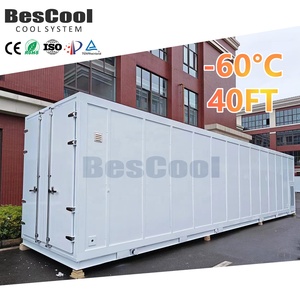
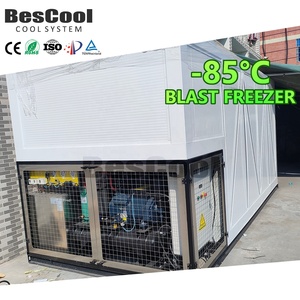
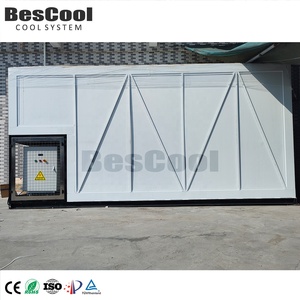
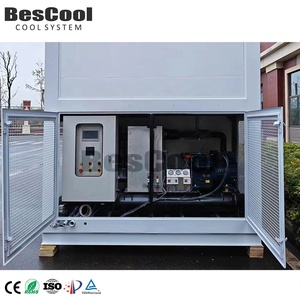
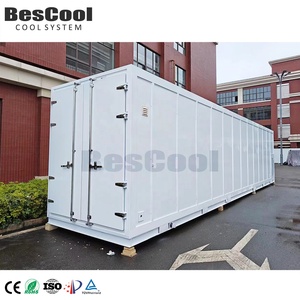























A containerized blast freezer is available in several variants to cater to different business needs. Containerized blast freezes work by blowing a strong current of cold air over the food item until it is completely frozen. Some popular types of blast freezers include:
IQF Freezer:
The individual quick freezing (IQF) freezer is popular in the food industry. It's designed to freeze small food items quickly. The durable conveyor belt transports food items through a high-velocity freezing tunnel. The IQF blast freezer works by blowing a strong current of cold air over small pieces of food like fruits, vegetables, and meat to freeze them individually. This prevents clumping and ensures that each food item retains its flavor, texture, and quality when it's defrosted later. The IQF freezer is perfect for freezing food items in high volumes. The IQF containerized freezer is available to help food businesses meet demand.
Tunnel Freezer:
The tunnel freezer is another popular type of containerized blast freezer. It's designed to freeze large batches of food quickly. The food item is exposed to a blast of cold air in an enclosed tunnel until it is completely frozen solid. This method of freezing is ideal for freezing food items that are not too small, like bread, baked goods, and cooked foods. Tunnel blast freezers are available in different sizes to meet the needs of small and large businesses. Businesses can also choose to purchase conveyor belt or tray-style tunnel freezers.
Spiral Freezer:
The spiral freezer is a more compact version of the tunnel freezer. Food items are placed on spiral-shaped conveyors to expose them to a constant blast of cold air until they are frozen. The spiral freezer takes up little space in a food production facility and is ideal for freezing items quickly in large batches. Like the tunnel freezer, the spiral freezer is suitable for freezing vegetables, fruits, meat, seafood, and poultry.
Containerized blast freezer offers specifications for commercial establishments working with perishable food products. Their primary function is to freeze food material and other items within a short time period. Typically, the standard containerized blast freezer capacity is around 20 to 40 tons per day. Some large industrial settings may go for the 40-foot containerized blast freezer as it can hold over 50 tons.
The freezing temperature of the blast freezer is within the range of -40 to -18 degrees centigrade. The temperature will vary based on the model and unit of measurement. Commercial settings often choose the ones that can reach up to -40 degrees centigrade as they are better for preserving food materials and ensuring perishables remain fresh.
The power source for a containerized blast freezer is either diesel or electric generators. Many commercial and industrial settings will hook it up to the power grid of the facility. Some may use generator power in remote locations. The operating power of the machine is from 15 to 45 kilowatts. Different models will use varying power levels.
A containerized blast freezer's airflow volume is crucial as it determines how quickly items will freeze. Depending on the size and model, it can be anywhere from 1000 to 5000 cubic meters per hour. Businesses with large quantities of food products to freeze should look for options with high airflow volume.
With proper usage, containerized blast freezers are low-maintenance. Simple cleaning and routine inspection of electrical parts, marketing systems, and gasket seals are required to keep the unit running. The technical team will do a preventative maintenance inspection once a year. During the inspection, coil cleaning will be done. Any small wear and tear found in parts will be replaced.
Users should be aware that damage and malfunction are mostly caused by improper use of the blast freezer. Get operator training for staff working with the unit. Make sure staff knows the items that should not be put in the freezer. Follow the guidelines to load products in and their placement inside the container.
The containerized blast freezer is effective in many industries. Its portability makes it convenient for businesses looking to reduce the cost of transporting food items or meat products. Here are some of the industries or businesses where containerized blast freezers are used:
Food processing facilities
These facilities process different types of food, including fruits, vegetables, poultry, dough, fish, and meat. Containerized blast freezers are used to blast freeze food products quickly. This helps to preserve the taste, nutritional value, and texture of the food products.
Restaurants and catering services
Blast freezers are useful in the food service industry. Restaurants and catering services use them for freezing prepared meals, dough, and desserts. The freezer allows food businesses to store food items for future use without compromising quality.
Cold storage facilities
A containerized blast freezer is an excellent addition to cold storage facilities. The freezer helps to increase storage capacity. It also improves the efficiency of the facility by reducing the time it takes to cool down and freeze food products.
Supermarkets and grocery chains
Supermarkets and grocery chains make use of containerized blast freezers when they need to preserve seasonal produce or freeze prepared food items. The unit helps to extend the shelf life of perishable items.
Dairy product manufacturing
The containerized blast freezer is used in the dairy industry for rapid freezing products like cheese, ice cream, and yogurt. Freezing these products quickly helps to maintain product consistency and prevents the formation of large ice crystals.
When purchasing containerized blast freezers for sale, clients can opt for customized or ready-made products depending on their specific requirements, preferred features, and refrigeration applications. Moreover, clients can select based on the guidelines listed below.
Q1: How long does it take an item to enter a blast freezer?
A1: Generally, 25 minutes to an hour for the product to start freezing. However, this depends on the containerized blast freezer's size and cooling capacity.
Q2: What is the highest freezer temperature?
A2: The highest blast freezing temperature is -20ºF or -29ºC. However, some containerized blast freezers can reach even lower temperatures of about -58ºF or -50ºC.
Q3: What is the difference between blast freezing and flash freezing?
A3: There is basically no difference between blast and flash freezing. Both terms refer to rapidly lowering an item's temperature to preserve it.
Q4: What is the difference between blast freezing and freezing?
A4: Unlike rapidly lowering the temperature of items to preserve their quality, ordinary freezing involves gradually lowering the temperature of items within a freezer. As such, ordinary freezing can alter the item's texture, taste, and quality.